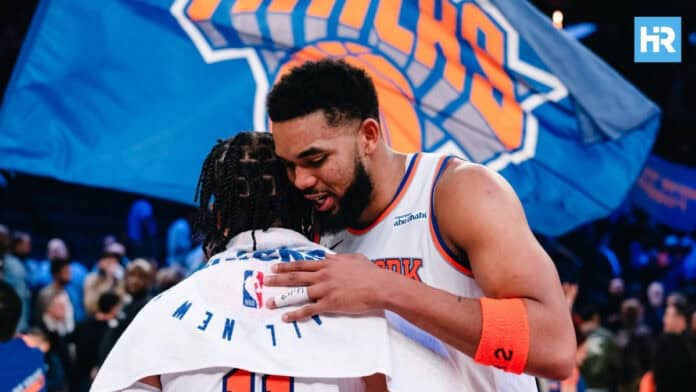When the dust finally settled on the flurry of activity that was this year’s NBA trade deadline, the New York Knicks were among the teams that chose a quieter path.
No blockbuster trades, no seismic shifts, just a subtle move that barely rippled through the news cycle.
They sent backup center Jericho Sims to the Milwaukee Bucks and, in return, brought in 10-year NBA veteran Delon Wright.
If this feels underwhelming for a team currently the third seed in the Eastern Conference with a 34-17 record, you’re not alone.
But what does this deal actually mean for the Knicks?
Was it a shrewd move that fits their calculated approach to team-building, or did they let an opportunity slip through their fingers?
To answer that, let’s take a closer look at the players involved and the context of the move.
Delon Wright: Can He Be More Than a Stopgap?
Delon Wright is, by all accounts, not having a good season—calling it rough might be an understatement.
His 2024-25 numbers look more like something out of a developmental league than a 10-year NBA veteran: 2.5 points, 1.8 rebounds, and 1.8 assists per game while shooting a horrendous 26.8% from the field and 24.5% from three-point range.
So why would the Knicks take a chance on a player who’s been this unproductive?
The answer lies in what Wright has done in the past and what he still potentially brings to the table.
At 6-foot-5, Wright is a smart and versatile defender who can guard multiple positions and disrupt opposing offenses.
He’s never been a go-to scorer, but the defense has been his calling card throughout his decade in the league.
Teams value that, even when the offensive side of his game disappears.
For the Knicks, who have struggled with depth and size on the perimeter, Wright fills a need—at least on paper.
He could become an insurance policy for their bench, which has leaned heavily on Immanuel Quickley and Quentin Grimes.
The question, though, is whether Wright can shake off his shooting woes and make meaningful contributions in a system where minutes aren’t guaranteed.
At this stage in his career, that’s a big “if.”
Jericho Sims: A Young Player, Let Go Too Soon?
On the other side of this trade is Jericho Sims, a player who might best be described as “unrealized potential.”
Sims, a second-round pick in 2021, hasn’t seen much action this season.
He’s athletic, energetic, and has the size (6-foot-10) to carve out a role as a rim-running big man.
But in Tom Thibodeau’s tight rotations, Sims became an afterthought, especially with Karl-Anthony Towns logging heavy minutes and Mitchell Robinson on the brink of returning from injury.
Sending Sims to the Milwaukee Bucks feels like a parting gift from the Knicks—a way to give the young center an opportunity to play somewhere he might be used.
Milwaukee, thin on big men behind Brook Lopez, Giannis Antetokounmpo, and Bobby Portis, is likely a better fit for Sims.
But did the Knicks let him go too soon?
It’s not often you find a 6-foot-10 athlete with untapped potential on an expiring contract.
Surely, the Knicks could have found a better return than Delon Wright and a bit of cash.
Or could they?
This wasn’t the first call the Knicks made about Sims.
Reports suggest the team shopped him to Dallas, New Orleans, and San Antonio before landing on Milwaukee as the best fit.
This feels more like a goodwill move than a business one—an unspoken thank-you for Sims’ patience while being underutilized in New York.
Mitchell Robinson: The Real Story Behind the Deadline
For all the focus on Wright and Sims, the real reason the Knicks didn’t make a bigger splash at the deadline lies in Mitchell Robinson.
Robinson, their defensive anchor, is on the verge of returning from ankle surgery that has kept him out since April.
And make no mistake—Robinson’s return is as big as any trade the Knicks could have made.
When healthy, Robinson is a game-changer.
His rim protection and offensive rebounding are elite, and his presence in the paint makes life miserable for opposing offenses.
The problem, of course, is keeping him healthy.
Robinson has missed significant time over the past few seasons, and his durability is a constant concern.
Still, the Knicks seem confident that Robinson’s return will address their biggest weaknesses, particularly on defense.
This is why the team didn’t go all-in at the trade deadline.
Robinson is their midseason “acquisition.”
But what happens if he gets hurt again?
Without Sims, the Knicks are left with just Karl-Anthony Towns, Precious Achiuwa, and Ariel Hukporti as their natural frontcourt players.
That’s a thin rotation for a playoff run, and it feels risky to put all their eggs in Robinson’s fragile basket.
The Buyout Market: A Waiting Game
The trade deadline may be over, but the Knicks still have an open roster spot and a chance to improve.
The buyout market, which will heat up as teams finalize their rosters, offers New York a second chance to bolster their bench.
But there’s a catch—as a first-apron team, the Knicks are restricted from signing players who made more than $12.8 million before being waived.
This rules out many of the bigger names likely to hit the market, such as Malcolm Brogdon or Bruce Brown.
That leaves the Knicks hunting for mid-tier players who fit their needs.
Chris Duarte, known for his defense and three-point shooting, could be a solid target.
So could Torrey Craig, a veteran who brings size and versatility.
Alternatively, the Knicks could promote TJ Warren from their G League affiliate, the Westchester Knicks.
Warren has the scoring ability and experience to help the team, even if he’s not the player he once was.
Was This Deadline a Missed Opportunity?
At first glance, the Knicks’ trade deadline feels underwhelming.
They didn’t make a major move, didn’t address their frontcourt depth, or bring in anyone who moves the needle offensively.
But this was never going to be a big-splash deadline for New York.
The team is 34-17, one of the top five in the league, and already made its big moves in the offseason by acquiring Karl-Anthony Towns and Mikal Bridges.
This deadline was about fine-tuning, not reinventing.
Still, the decision to trade Sims for Wright feels like a gamble that might not pay off.
Wright’s best days might be behind him, and relying on Robinson’s health is a high-stakes bet.
The buyout market offers some hope, but the Knicks will need to act quickly and decisively to fill their remaining gaps.
In the end, the Knicks are betting that the team they’ve built is already good enough to compete.
And maybe it is.
But in a league where every advantage matters, standing still can feel dangerously close to falling behind.
Time will tell if this quiet trade deadline was the right call—or a missed opportunity.






